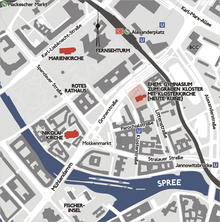




The Franziskaner-Klosterkirche was a church in the Mitte district of Berlin, Germany, founded in 1250 and now in ruins.





The Franziskaner-Klosterkirche was a church in the Mitte district of Berlin, Germany, founded in 1250 and now in ruins.
It was founded in 1250 in the early Gothic style as a monastery church for a Franciscan house. It was a fieldstone church, 52 metres long and 16 metres wide. Its remains can be found in the north wall of the present ruins. This was replaced with a three-aisled brick basilica church, begun at the end of the 13th century and completed in the first half of the 14th century, whose ruins still survive. In 1365 Louis II, Elector of Brandenburg was buried there. Around 1500 it was renovated.
The monastery was closed due to the Protestant Reformation's arrival in Berlin in 1539. None of the monastic buildings survive, though some of them housed Berlin's first printing press from 1571 and the Evangelisches Gymnasium zum Grauen Kloster from 1574. Pupils and teachers at the latter included Karl Friedrich Schinkel and Friedrich Ludwig Jahn, whilst Otto von Bismarck also visited the church. Leonhard Thurneysser ran the printing press and also restored the church between 1583 and 1584.
Small modifications were made in the second half of the 17th century, such as demolishing the old staircase tower, building a new timber staircase on the west side and in 1712 demolishing the rood screen separating the nave from the chancel. 1712 also saw a fire in the church's roof and in 1719 the church was restored, raising the floor level by 1 metre and bricking up two northern choir windows.
Extensive renovations were carried out in the first half of the 19th century - the gabled tower was demolished in 1826, two new towers were built on the west side in 1842, a new sacristy was built and the floor lowered again. Plans were produced for the work by Karl Friedrich Schinkel, Christian Gottlieb Cantian and the former track-inspector Berger was preceded by the construction work - Berger's second design was that ultimately implemented. Work lasted until 1845, though the church was closed due to severe damp in its masonry in 1902 and in 1926 most of the 19th century changes were reversed. The church was re-consecrated on 24 May 1936.
The church was destroyed on 3 April 1945 in the bombing of Berlin in World War II. In 1950 the debris was removed and the church ruins secured between 1959 and 1963, although the ruined monastic buildings were demolished completely to make way for a park. The ruins were restored again in 2003-2004 and are now used for exhibitions, plays and concerts.

The Gendarmenmarkt is a square in Berlin and the site of an architectural ensemble that includes the Berlin concert hall, along with the French and German Churches. In the centre of the square stands a monumental statue of poet Friedrich Schiller. The square was created by Johann Arnold Nering at the end of the seventeenth century as the Linden-Markt and reconstructed by Georg Christian Unger in 1773. The Gendarmenmarkt is named after a Prussian cuirassier regiment called the Gendarmen, which had stables at the square until 1773.
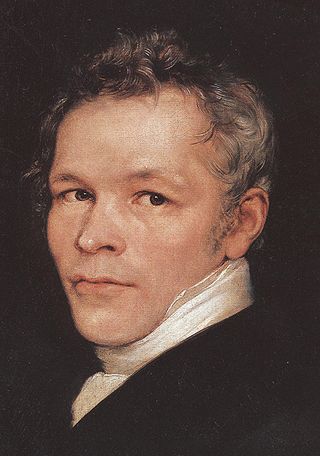
Karl Friedrich Schinkel was a Prussian architect, city planner and painter who also designed furniture and stage sets. Schinkel was one of the most prominent architects of Germany and designed both Neoclassical and neo-Gothic buildings. His most famous buildings are found in and around Berlin.

Berlin Cathedral, also known as the Evangelical Supreme Parish and Collegiate Church, is a monumental German Protestant church and dynastic tomb on the Museum Island in central Berlin. Having its origins as a castle chapel for the Berlin Palace, several structures have served to house the church since the 15th century. The present collegiate church was built from 1894 to 1905 by order of Emperor William II according to plans by Julius Raschdorff in Renaissance and Baroque Revival styles. The listed building is the largest Protestant church in Germany and one of the most important dynastic tombs in Europe. In addition to church services, the cathedral is used for state ceremonies, concerts and other events.
Münsterschwarzach Abbey, is a monastery for Benedictine monks in Germany. It is located at the confluence of the rivers Schwarzach and Main in Bavaria.

The Bauakademie in Berlin, Germany, was a higher education institution for the art of building to train master builders. Founded on 18 March 1799 by King Frederick William III, the institution originated from the construction department of the Academy of Fine Arts and Mechanical Sciences, which emphasized the aesthetic elements of the art of building while ignoring the technical. Thus, the governmental Upper Building Department ("UBD") decided to establish an entirely new building educational institution named "Bauakademie". In 1801, the institution was incorporated into the UBD.

Friedrich August Stüler was an influential Prussian architect and builder. His masterpiece is the Neues Museum in Berlin, as well as the dome of the triumphal arch of the main portal of the Berliner Schloss.

Friedrichswerder Church was the first Neo-Gothic church built in Berlin, Germany. It was designed by an architect better known for his Neoclassical architecture, Karl Friedrich Schinkel, and was built under his direction from 1824 to 1831.

The Evangelisches Gymnasium zum Grauen Kloster, located in suburban Schmargendorf, Berlin, is an independent school with a humanistic profile, known as one of the most prestigious schools in Germany. Founded by the Evangelical Church in West Berlin in 1949 as the Evangelisches Gymnasium, it continues the traditions of the ancient Berlinisches Gymnasium zum Grauen Kloster, the oldest Gymnasium in Berlin, which for hundreds of years was situated in former monastery buildings in the city's Mitte district, closed by the East Germans in 1958. In 1963 the Evangelisches Gymnasium of West Berlin adopted its traditions and added "zum Grauen Kloster" to its name.
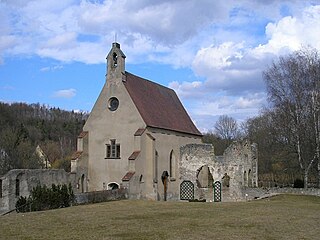
Christgarten Charterhouse is a former Carthusian monastery, or charterhouse, near Ederheim in Bavaria, Germany.

The Luisenstädtische Kirche was a church building in Berlin, in the former Luisenstadt district, on Alte Jacobstraße between Sebastianstraße and Stallschreiberstraße. It was originally known as the Kirche in der Cöpenicker Vorstadt, then from 1785 to 1795 as the Köllnische Vorstadtkirche, then from 1795 to 1837 as the Sebastiankirche, after presbyter and city-councillor Sebastian Nethe, taking its final name in 1837.

Johann August Karl Soller was a Prussian, and later, German architect. He was one of the most important of Karl Friedrich Schinkel's pupils and is regarded as a representative of the Schinkel school. Soller became an influential proponent of Rundbogenstil, a Romanesque revival architectural style that became popular in German-speaking lands and among German diaspora during the 19th century.
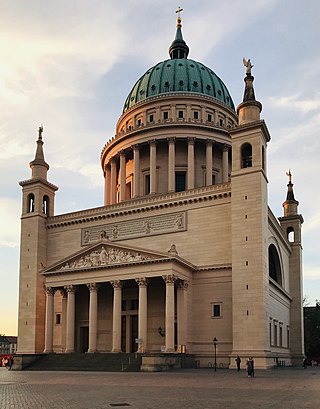
St. Nicholas Church in Potsdam is a Lutheran church under the Evangelical Church in Berlin, Brandenburg and Silesian Upper Lusatia of the Evangelical Church in Germany on the Old Market Square in Potsdam. The central plan building in the Classicist style and dedicated to Saint Nicholas was built to plans by Karl Friedrich Schinkel in the years 1830 to 1837. The tambour of the 77-metre-high church that towers above the roofs of the city was built later, from 1843 to 1850. Its construction was taken over by Ludwig Persius and, from 1845, Friedrich August Stüler.

Wirberg is a former monastery complex in the district of Giessen. It is located on the eastern edge of the municipality of Reiskirchen between Saasen and Göbelnrod, and about eight miles north-west of Grünberg. The church was once the Protestant Church serving the Grünberg districts of Göbelnrod, Beltershain, Harbach, Weitershain and Reinhardshain. Today, it is used as a church on special occasions.
Carl Heinrich Hermann was a German fresco-painter.
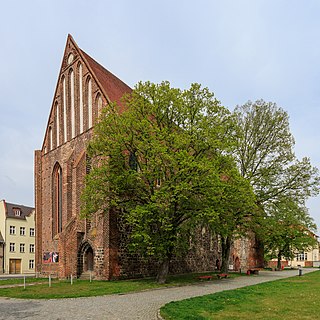
The Church of St. Peter and St. Paul is a former church in Angermünde.

Villach Friary is a Franciscan friary, responsible for the parish of St. Nicholas in Villach, Carinthia, Austria.
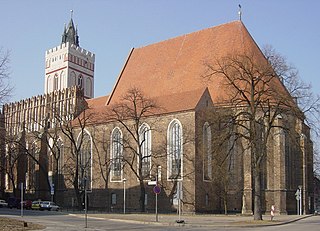
The Marienkirche or St. Mary’s Church, Frankfurt (Oder) is a Protestant church in Frankfurt (Oder) in Germany in the Brick Gothic style. It was formerly the city's main parish church and was built over more than 250 years, during the Middle Ages.
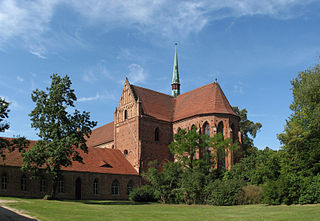
Chorin Abbey is a former Cistercian abbey near the village of Chorin in Brandenburg, Germany. It was founded by the Ascanian margraves in 1258 and had far-reaching influence on the northern edge of the Ascanians' sphere of influence, where it bordered with the Slavs. It was secularized in 1542 and allowed to decay until the early 19th century, when the ruins were restored and the building partly rebuilt under the direction of Karl Friedrich Schinkel. It is now an archetypal example of the Brick Gothic style and part of the Deutsch-Polnisches Klosternetzwerk.

St. Christopher Church is the Protestant-Lutheran parish church located in the village of Reinhausen in the district of Göttingen, Lower Saxony. The church stands on the sandstone rock of the Kirchberg above the village center. It was originally built as a castle chapel by the Counts of Reinhausen in the 10th century and later served as a church for the collegiate monastery and the Benedictine monastery of Reinhausen that emerged from it in the 12th century. The church in Reinhausen, commonly known as the Reinhausen monastery church, has served as the parish church of the village of Reinhausen for many years. Following the introduction of the Reformation in 1542, the monastery was gradually dissolved, and the church was then solely used as a parish church, with brief interruptions. Today, it belongs to the Göttingen church district in the Hildesheim-Göttingen branch of the Hanoverian regional church.